16.4E: Mazoezi ya Sehemu ya 16.4
- Page ID
- 178931
Kwa mazoezi yafuatayo, tathmini mchanganyiko wa mstari kwa kutumia theorem ya Green.
1. \(\displaystyle \int_C 2xy\,dx+(x+y)\,dy\),\(C\) wapi njia kutoka\((0, 0)\) hadi\((1, 1)\) kwenye grafu ya\(y=x^3\) na kutoka\((1, 1)\) kwa\((0, 0)\) pamoja na grafu ya\(y=x\) oriented katika mwelekeo kinyume
2. \(\displaystyle \int_C 2xy\,dx+(x+y)\,dy\),\(C\) wapi mipaka ya kanda iliyopo kati ya grafu ya\(y=0\) na\(y=4−x^2\) inaelekezwa katika mwelekeo wa kinyume
- Jibu
- \(\displaystyle \int_C2xy\,dx+(x+y)\,dy=\frac{32}{3}\)vitengo vya kazi
3. \(\displaystyle \int_C 2\arctan\left(\frac{y}{x}\right)\,dx+\ln(x^2+y^2)\,dy\), wapi\(C\) hufafanuliwa na\(x=4+2\cos θ,\;y=4\sin θ\) kuelekezwa katika mwelekeo wa kinyume
4. \(\displaystyle \int_C \sin x\cos y\,dx+(xy+\cos x\sin y)\,dy\),\(C\) wapi mipaka ya kanda iliyopo kati ya grafu ya\(y=x\) na\(y=\sqrt{x}\) inaelekezwa katika mwelekeo wa kinyume
- Jibu
- \(\displaystyle \int_C\sin x\cos y\,dx+(xy+\cos x\sin y)\,dy=\frac{1}{12}\)vitengo vya kazi
5. \(\displaystyle \int_C xy\,dx+(x+y)\,dy\),\(C\) wapi mipaka ya kanda iliyopo kati ya grafu ya\(x^2+y^2=1\) na\(x^2+y^2=9\) inaelekezwa katika mwelekeo wa kinyume
6. \(\displaystyle ∮_C (−y\,dx+x\,dy)\), ambapo\(C\) ina sehemu ya mstari\(C_1\) kutoka\((−1,0)\) kwa\((1, 0)\), ikifuatiwa na arc semicircular\(C_2\) kutoka\((1, 0)\) nyuma\((-1, 0)\)
- Jibu
- \(\displaystyle ∮_C (−y\,\,dx+x\,\,dy)=π\)vitengo vya kazi
Kwa mazoezi yafuatayo, tumia theorem ya Green.
7. Hebu\(C\) kuwa Curve yenye makundi ya mstari kutoka\((1, 1)\) kwa\((0, 0)\) kwenda\((0, 1)\) na kurudi\((0, 0)\). Kupata thamani ya\(\displaystyle \int_C xy\,dx+\sqrt{y^2+1}\,dy\).
8. Tathmini mstari muhimu\(\displaystyle \int_C xe^{−2x}\,dx+(x^4+2x^2y^2)\,dy\), wapi\(C\) mipaka ya kanda kati ya miduara\(x^2+y^2=1\) na\(x^2+y^2=4\), na ni Curve chanya oriented.
- Jibu
- \(\displaystyle \int_C xe^{−2x}\,dx+(x^4+2x^2y^2)\,dy=0\)vitengo vya kazi
9. Kupata mzunguko kinyume cha shamba\(\vecs F(x,y)=xy\,\mathbf{\hat i}+y^2\,\mathbf{\hat j}\) karibu na juu ya mipaka ya kanda iliyoambatanishwa\(y=x^2\) na curves na\(y=x\) katika roboduara ya kwanza na oriented katika mwelekeo kinyume.
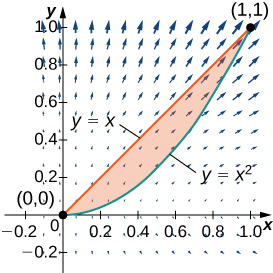
10. Tathmini\(\displaystyle ∮_C y^3\,dx−x^3y^2\,dy\),\(C\) wapi mduara unaoelekezwa vizuri wa radius\(2\) unaozingatia asili.
- Jibu
- \(\displaystyle ∮_C y^3\,dx−x^3y^2\,dy=−20π\)vitengo vya kazi
11. Tathmini\(\displaystyle ∮_C y^3\,dx−x^3\,dy\), ambapo\(C\) inajumuisha miduara miwili ya radius\(2\) na radius\(1\) iliyozingatia asili, wote wenye mwelekeo mzuri.
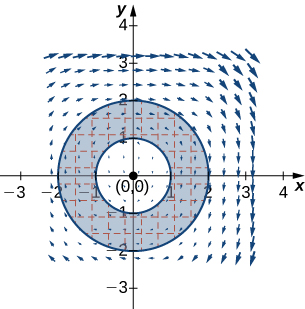
12. Tumia\(\displaystyle ∮_C −x^2y\,dx+xy^2\,dy\),\(C\) wapi mduara wa radius\(2\) unaozingatia asili na unaelekezwa katika mwelekeo wa kinyume.
- Jibu
- \(\displaystyle ∮_C −x^2y\,dx+xy^2\,dy=8π\)vitengo vya kazi
13. Tumia hesabu muhimu\(\displaystyle ∮_C 2[y+x\sin(y)]\,dx+[x^2\cos(y)−3y^2]\,dy\) pamoja\(C\) na pembetatu\((0, 0), \,(1, 0)\) na vipeo na\((1, 1)\), inaelekezwa kinyume chake, kwa kutumia theorem ya Green.
14. Kutathmini muhimu\(\displaystyle ∮_C (x^2+y^2)\,dx+2xy\,dy\), ambapo\(C\) ni Curve inayofuata parabola\(y=x^2\) kutoka\((0,0), \,(2,4),\) kisha line kutoka\((2, 4)\) kwa\((2, 0)\), na hatimaye line kutoka\((2, 0)\) kwa\((0, 0)\).
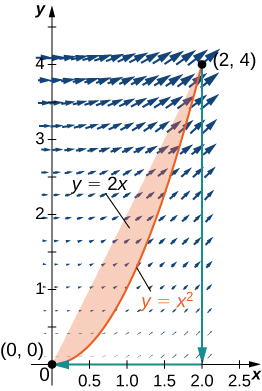
- Jibu
- \(\displaystyle ∮_C (x^2+y^2)\,dx+2xy\,dy=0\)vitengo vya kazi
15. Kutathmini line muhimu\(\displaystyle ∮_C (y−\sin(y)\cos(y))\,dx+2x\sin^2(y)\,dy\), ambapo\(C\) ni oriented katika njia kinyume kuzunguka eneo imepakana na\(x=−1, \,x=2, \,y=4−x^2\), na\(y=x−2.\)
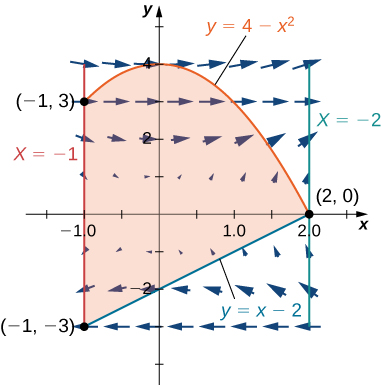
Kwa mazoezi yafuatayo, tumia theorem ya Green ili kupata eneo hilo.
16. Pata eneo kati ya ellipse\(\frac{x^2}{9}+\frac{y^2}{4}=1\) na mduara\(x^2+y^2=25\).
- Jibu
- \(A=19π\;\text{units}^2\)
17. Pata eneo la kanda iliyofungwa na equation ya parametric
\(\vecs p(θ)=(\cos(θ)−\cos^2(θ))\,\mathbf{\hat i}+(\sin(θ)−\cos(θ)\sin(θ))\,\mathbf{\hat j}\)kwa\(0≤θ≤2π.\)
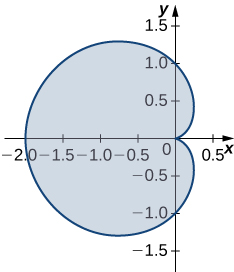
18. Pata eneo la kanda lililofungwa na hypocycloid\(\vecs r(t)=\cos^3(t)\,\mathbf{\hat i}+\sin^3(t)\,\mathbf{\hat j}\). Curve ni parameterized na\(t∈[0,2π].\)
- Jibu
- \(A=\frac{3}{8π}\;\text{units}^2\)
19. Pata eneo la pentagon na vipeo\((0,4), \,(4,1), \,(3,0), \,(−1,−1),\) na\((−2,2)\).
20. Tumia theorem ya Green kutathmini\(\displaystyle \int_{C^+}(y^2+x^3)\,dx+x^4\,dy\),\(C^+\) wapi mzunguko wa mraba\([0,1]×[0,1]\) unaoelekezwa kinyume chake.
- Jibu
- \(\displaystyle \int_{C^+} (y^2+x^3)\,dx+x^4\,dy=0\)
21. Tumia theorem ya Green ili kuthibitisha eneo la disk na radius\(a\) ni\(A=πa^2\;\text{units}^2\).
22. Tumia theorem ya Green ili kupata eneo la kitanzi kimoja cha rose ya jani nne\(r=3\sin 2θ\). (Kidokezo:\(x\,dy−y\,dx=r^2\,dθ\)).
- Jibu
- \(A=\frac{9π}{8}\;\text{units}^2\)
23. Tumia theorem ya Green kupata eneo chini ya arch moja ya cycloid iliyotolewa na equations parametric:\(x=t−\sin t,\;y=1−\cos t,\;t≥0.\)
24. Matumizi Theorem Green ya kupata eneo la mkoa iliyoambatanishwa na Curve
\(\vecs r(t)=t^2\,\mathbf{\hat i}+\left(\frac{t^3}{3}−t\right)\,\mathbf{\hat j},\)kwa\(−\sqrt{3}≤t≤\sqrt{3}\).
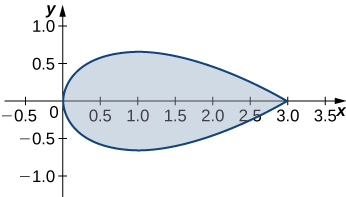
- Jibu
- \(A=\frac{8\sqrt{3}}{5}\;\text{units}^2\)
25. [T] Tathmini theorem ya Green kwa kutumia mfumo wa algebra ya kompyuta ili kutathmini muhimu\(\displaystyle \int_C xe^y\,dx+e^x\,dy\), wapi\(C\) mduara uliotolewa\(x^2+y^2=4\) na na unaelekezwa katika mwelekeo kinyume chake.
26. Tathmini\(\displaystyle \int_C(x^2y−2xy+y^2)\,ds\),\(C\) wapi mipaka ya mraba wa kitengo\(0≤x≤1,\;0≤y≤1\), ilipitia kinyume chake.
- Jibu
- \(\displaystyle \int_C (x^2y−2xy+y^2)\,ds=3\)
27. Tathmini\(\displaystyle \int_C \frac{−(y+2)\,dx+(x−1)\,dy}{(x−1)^2+(y+2)^2}\), ambapo\(C\) ni rahisi kufungwa Curve na mambo ya ndani ambayo haina uhakika\((1,−2)\) traversed kinyume chake.
28. Tathmini\(\displaystyle \int_C \frac{x\,dx+y\,dy}{x^2+y^2}\),\(C\) wapi piecewise yoyote, laini rahisi imefungwa Curve enclosing asili, kupita kinyume chake.
- Jibu
- \(\displaystyle \int_C \frac{x\,dx+y\,dy}{x^2+y^2}=2π\)
Kwa mazoezi yafuatayo, tumia theorem ya Green ili kuhesabu kazi iliyofanywa kwa nguvu\(\vecs F\) kwenye chembe inayohamia kinyume chake karibu na njia iliyofungwa\(C\).
29. \(\vecs F(x,y)=xy\,\mathbf{\hat i}+(x+y)\,\mathbf{\hat j}, \quad C:x^2+y^2=4\)
30. \(\vecs F(x,y)=(x^{3/2}−3y)\,\mathbf{\hat i}+(6x+5\sqrt{y})\,\mathbf{\hat j}, \quad C\): boundary of a triangle with vertices \((0, 0), \,(5, 0),\) and \((0, 5)\)
- Answer
- \(W=\frac{225}{2}\) units of work
31. Evaluate \(\displaystyle \int_C (2x^3−y^3)\,dx+(x^3+y^3)\,dy\), where \(C\) is a unit circle oriented in the counterclockwise direction.
32. A particle starts at point \((−2,0)\), moves along the \(x\)-axis to \((2, 0)\), and then travels along semicircle \(y=\sqrt{4−x^2}\) to the starting point. Use Green’s theorem to find the work done on this particle by force field \(\vecs F(x,y)=x\,\mathbf{\hat i}+(x^3+3xy^2)\,\mathbf{\hat j}\).
- Answer
- \(W=12π\) units of work
33. David and Sandra are skating on a frictionless pond in the wind. David skates on the inside, going along a circle of radius \(2\) in a counterclockwise direction. Sandra skates once around a circle of radius \(3\), also in the counterclockwise direction. Suppose the force of the wind at point \((x,y)\) is \(\vecs F(x,y)=(x^2y+10y)\,\mathbf{\hat i}+(x^3+2xy^2)\,\mathbf{\hat j}\). Use Green’s theorem to determine who does more work.
34. Use Green’s theorem to find the work done by force field \(\vecs F(x,y)=(3y−4x)\,\mathbf{\hat i}+(4x−y)\,\mathbf{\hat j}\) when an object moves once counterclockwise around ellipse \(4x^2+y^2=4.\)
- Answer
- \(W=2π\) units of work
35. Use Green’s theorem to evaluate line integral \(\displaystyle ∮_C e^{2x}\sin 2y\,dx+e^{2x}\cos 2y\,dy\), where \(C\) is ellipse \(9(x−1)^2+4(y−3)^2=36\) oriented counterclockwise.
36. Evaluate line integral \(\displaystyle ∮_C y^2\,dx+x^2\,dy\), where \(C\) is the boundary of a triangle with vertices \((0,0), \,(1,1)\), and \((1,0)\), with the counterclockwise orientation.
- Answer
- \(\displaystyle ∮_C y^2\,dx+x^2\,dy=\frac{1}{3}\) units of work
37. Use Green’s theorem to evaluate line integral \(\displaystyle \int_C \vecs h·d\vecs r\) if \(\vecs h(x,y)=e^y\,\mathbf{\hat i}−\sin πx\,\mathbf{\hat j}\), where \(C\) is a triangle with vertices \((1, 0), \,(0, 1),\) and \((−1,0),\) traversed counterclockwise.
38. Use Green’s theorem to evaluate line integral \(\displaystyle \int_C\sqrt{1+x^3}\,dx+2xy\,dy\) where \(C\) is a triangle with vertices \((0, 0), \,(1, 0),\) and \((1, 3)\) oriented clockwise.
- Answer
- \(\displaystyle \int_C \sqrt{1+x^3}\,dx+2xy\,dy=3\) units of work
39. Use Green’s theorem to evaluate line integral \(\displaystyle \int_C x^2y\,dx−xy^2\,dy\) where \(C\) is a circle \(x^2+y^2=4\) oriented counterclockwise.
40. Use Green’s theorem to evaluate line integral \(\displaystyle \int_C \left(3y−e^{\sin x}\right)\,dx+\left(7x+\sqrt{y^4+1}\right)\,dy\) where \(C\) is circle \(x^2+y^2=9\) oriented in the counterclockwise direction.
- Answer
- \(\displaystyle \int_C \left(3y−e^{\sin x}\right)\,dx+\left(7x+\sqrt{y^4+1}\right)\,dy=36π\) units of work
41. Use Green’s theorem to evaluate line integral \(\displaystyle \int_C (3x−5y)\,dx+(x−6y)\,dy\), where \(C\) is ellipse \(\frac{x^2}{4}+y^2=1\) and is oriented in the counterclockwise direction.
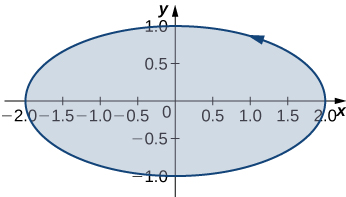
42. Let \(C\) be a triangular closed curve from \((0, 0)\) to \((1, 0)\) to \((1, 1)\) and finally back to \((0, 0).\) Let \(\vecs F(x,y)=4y\,\mathbf{\hat i}+6x^2\,\mathbf{\hat j}.\) Use Green’s theorem to evaluate \(\displaystyle ∮_C\vecs F·d\vecs r.\)
- Answer
- \(\displaystyle ∮_C\vecs F·d\vecs r=2\) units of work
43. Use Green’s theorem to evaluate line integral \(\displaystyle ∮_C y\,dx−x\,dy\), where \(C\) is circle \(x^2+y^2=a^2\) oriented in the clockwise direction.
44. Use Green’s theorem to evaluate line integral \(\displaystyle ∮_C (y+x)\,dx+(x+\sin y)\,dy,\) where \(C\) is any smooth simple closed curve joining the origin to itself oriented in the counterclockwise direction.
- Answer
- \(\displaystyle ∮_C (y+x)\,dx+(x+\sin y)\,dy=0\) units of work
45. Use Green’s theorem to evaluate line integral \(\displaystyle ∮_C \left(y−\ln(x^2+y^2)\right)\,dx+\left(2\arctan \frac{y}{x}\right)\,dy,\) where \(C\) is the positively oriented circle \((x−2)^2+(y−3)^2=1.\)
46. Use Green’s theorem to evaluate \(\displaystyle ∮_C xy\,dx+x^3y^3\,dy,\) where \(C\) is a triangle with vertices \((0, 0), \,(1, 0),\) and \((1, 2)\) with positive orientation.
- Answer
- \(\displaystyle ∮_C xy\,dx+x^3y^3\,dy=2221\) units of work
47. Use Green’s theorem to evaluate line integral \(\displaystyle \int_C \sin y\,dx+x\cos y\,dy,\) where \(C\) is ellipse \(x^2+xy+y^2=1\) oriented in the counterclockwise direction.
48. Let \(\vecs F(x,y)=\left(\cos(x^5)−13y^3\right)\,\mathbf{\hat i}+13x^3\,\mathbf{\hat j}.\) Find the counterclockwise circulation \(\displaystyle ∮_C\vecs F·d\vecs r,\) where \(C\) is a curve consisting of the line segment joining \((−2,0)\) and \((−1,0),\) half circle \(y=\sqrt{1−x^2},\) the line segment joining \((1, 0)\) and \((2, 0),\) and half circle \(y=\sqrt{4−x^2}.\)
- Answer
- \(\displaystyle ∮_C\vecs F·d\vecs r=15π^4\) units of work
49. Use Green’s theorem to evaluate line integral \(\displaystyle ∫_C \sin(x^3)\,dx+2ye^{x^2}\,dy,\) where \(C\) is a triangular closed curve that connects the points \((0, 0), \,(2, 2),\) and \((0, 2)\) counterclockwise.
50. Let \(C\) be the boundary of square \(0≤x≤π,\;0≤y≤π,\) traversed counterclockwise. Use Green’s theorem to find \(\displaystyle ∫_C \sin(x+y)\,dx+\cos(x+y)\,dy.\)
- Answer
- \(\displaystyle \int_C\sin(x+y)\,dx+\cos(x+y)\,dy=4\) units of work
51. Use Green’s theorem to evaluate line integral \(\displaystyle ∫_C \vecs F·d\vecs r,\) where \(\vecs F(x,y)=(y^2−x^2)\,\mathbf{\hat i}+(x^2+y^2)\,\mathbf{\hat j},\) and \(C\) is a triangle bounded by \(y=0,\;x=3,\) and \(y=x,\) oriented counterclockwise.
52. Use Green’s Theorem to evaluate integral \(\displaystyle ∫_C \vecs F·d\vecs r,\) where \(\vecs F(x,y)=(xy^2)\,\mathbf{\hat i}+x\,\mathbf{\hat j},\) and \(C\) is a unit circle oriented in the counterclockwise direction.
- Answer
- \(\displaystyle ∫_C \vecs F·d\vecs r=π\) units of work
53. Use Green’s theorem in a plane to evaluate line integral \(\displaystyle ∮_C (xy+y^2)\,dx+x^2\,dy,\) where \(C\) is a closed curve of a region bounded by \(y=x\) and \(y=x^2\) oriented in the counterclockwise direction.
54. Calculate the outward flux of \(\vecs F(x,y)=−x\,\mathbf{\hat i}+2y\,\mathbf{\hat j}\) over a square with corners \((±1,\,±1),\) where the unit normal is outward pointing and oriented in the counterclockwise direction.
- Answer
- \(\displaystyle ∮_C\vecs F·\vecs N \,ds=4\)
55. [T] Let \(C\) be circle \(x^2+y^2=4\) oriented in the counterclockwise direction. Evaluate \(\displaystyle ∮_C \left[\left(3y−e^{\arctan x})\,dx+(7x+\sqrt{y^4+1}\right)\,dy\right]\) using a computer algebra system.
56. Find the flux of field \(\vecs F(x,y)=−x\,\mathbf{\hat i}+y\,\mathbf{\hat j}\) across \(x^2+y^2=16\) oriented in the counterclockwise direction.
- Answer
- \(\displaystyle ∮_C \vecs F·\vecs N\,ds=32π\)
57. Let \(\vecs F=(y^2−x^2)\,\mathbf{\hat i}+(x^2+y^2)\,\mathbf{\hat j},\) and let \(C\) be a triangle bounded by \(y=0, \,x=3,\) and \(y=x\) oriented in the counterclockwise direction. Find the outward flux of \(\vecs F\) through \(C\).
58. [T] Let \(C\) be unit circle \(x^2+y^2=1\) traversed once counterclockwise. Evaluate \(\displaystyle ∫_C \left[−y^3+\sin(xy)+xy\cos(xy)\right]\,dx+\left[x^3+x^2\cos(xy)\right]\,dy\) by using a computer algebra system.
- Answer
- \(\displaystyle ∫_C \left[−y^3+\sin(xy)+xy\cos(xy)\right]\,dx+\left[x^3+x^2\cos(xy)\right]\,dy=4.7124\) units of work
59. [T] Find the outward flux of vector field \(\vecs F(x,y)=xy^2\,\mathbf{\hat i}+x^2y\,\mathbf{\hat j}\) across the boundary of annulus \(R=\big\{(x,y):1≤x^2+y^2≤4\big\}=\big\{(r,θ):1≤r≤2,\,0≤θ≤2π\big\}\) using a computer algebra system.
60. Consider region \(R\) bounded by parabolas \(y=x^2\) and \(x=y^2.\) Let \(C\) be the boundary of \(R\) oriented counterclockwise. Use Green’s theorem to evaluate \(\displaystyle ∮_C \left(y+e^{\sqrt{x}}\right)\,dx+\left(2x+\cos(y^2)\right)\,dy.\)
- Answer
- \(\displaystyle ∮_C \left(y+e^{\sqrt{x}}\right)\,dx+\left(2x+\cos(y^2)\right)\,dy=13\) units of work


